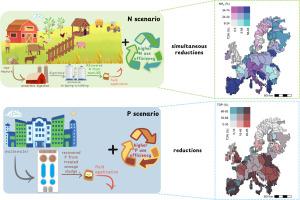减轻欧洲的营养损失:到2050年空气和水污染的协同解决方案
IF 10.9
1区 环境科学与生态学
Q1 ENGINEERING, ENVIRONMENTAL
引用次数: 0
摘要
在欧洲,农业和城市化经常造成氮(N)和磷(P)的损失,并造成相关的环境影响。在这里,我们的目标是量化利用粪肥处理中回收的氮和处理过的污水污泥中回收的磷的影响,提高农业中氮和磷的利用效率,改善污水处理对减少未来营养物排放到空气中的影响,以及对欧洲河流和海洋的损失。通过探索协同选择,我们表明,到2050年,通过ReNuRe产品,预计空气中的氮含量将减少30%,氮的利用效率将提高。与未来的基线情景相比,预计河流吸收的营养物质将减少23 - 68%。与未来的基准线相比,这些河流输出的营养物质可能会减少三分之二。从处理过的污水污泥中回收的磷可以满足欧洲2050年的磷肥需求。我们的分析支持采用生物基肥料,以减轻养分损失,促进循环经济。本文章由计算机程序翻译,如有差异,请以英文原文为准。

Mitigating nutrient losses in Europe: Synergistic solutions for air and water pollution by 2050
Agriculture and urbanization often cause nitrogen (N) and phosphorus (P) losses, and associated environmental impacts in Europe. Here, we aim to quantify the effects of using recovered N from manure processing and recovered P from treated sewage sludge, increasing N and P use efficiencies in agriculture, and improving sewage treatments on reducing future nutrient emissions to the air, and losses to rivers and seas of Europe. Exploring synergistic options we show that 30 % less N is expected in the air via ReNuRe products and higher N use efficiency by 2050. Rivers are projected to receive 23–68 % less nutrients relative to the future baseline scenario. These rivers may export up to two-thirds less nutrients relative to the future baseline. Recovered P from treated sewage sludge can fulfill P fertilizer need in Europe in 2050. Our analysis supports the adoption of bio-based fertilizers to mitigate nutrient losses and contributes to circular economy.
求助全文
通过发布文献求助,成功后即可免费获取论文全文。
去求助
来源期刊

Resources Conservation and Recycling
环境科学-工程:环境
CiteScore
22.90
自引率
6.10%
发文量
625
审稿时长
23 days
期刊介绍:
The journal Resources, Conservation & Recycling welcomes contributions from research, which consider sustainable management and conservation of resources. The journal prioritizes understanding the transformation processes crucial for transitioning toward more sustainable production and consumption systems. It highlights technological, economic, institutional, and policy aspects related to specific resource management practices such as conservation, recycling, and resource substitution, as well as broader strategies like improving resource productivity and restructuring production and consumption patterns.
Contributions may address regional, national, or international scales and can range from individual resources or technologies to entire sectors or systems. Authors are encouraged to explore scientific and methodological issues alongside practical, environmental, and economic implications. However, manuscripts focusing solely on laboratory experiments without discussing their broader implications will not be considered for publication in the journal.
 求助内容:
求助内容: 应助结果提醒方式:
应助结果提醒方式:


